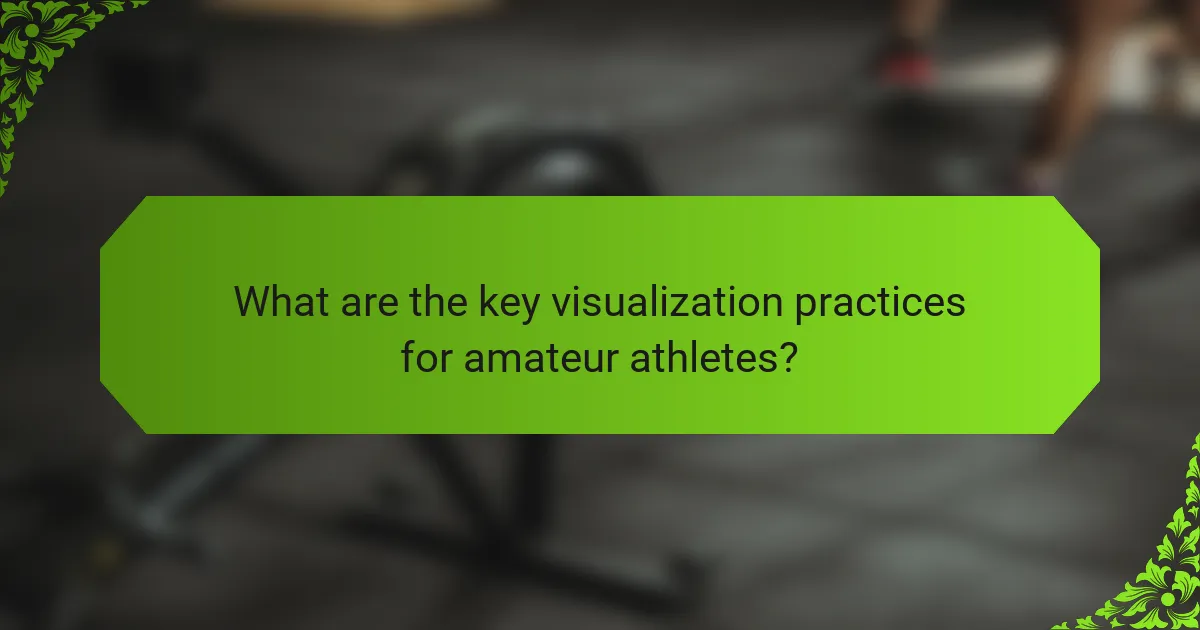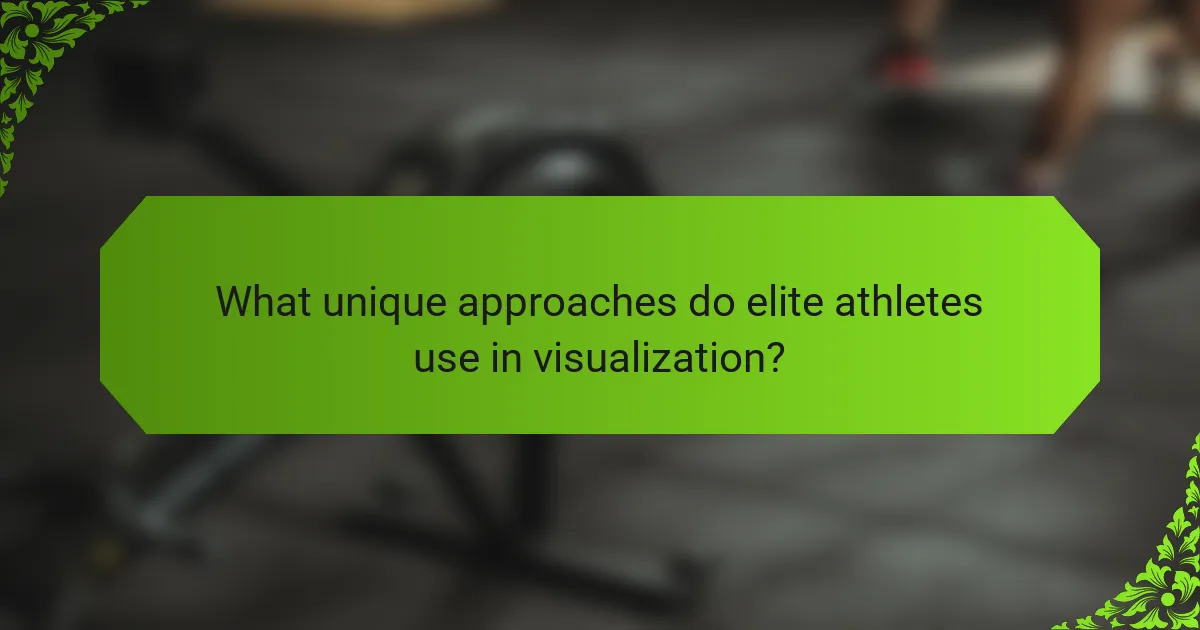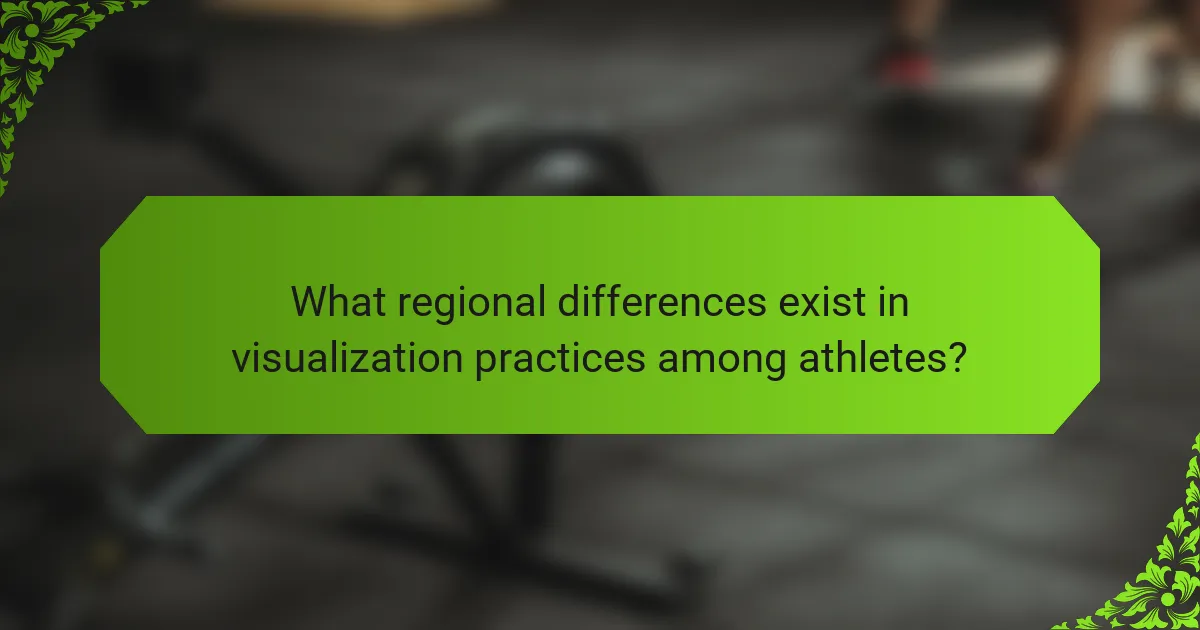Visualization practices can significantly enhance performance and focus for amateur athletes. Key techniques include mental imagery for successful performances, relaxation methods, and scenario planning for competition. Engaging all senses during visualization improves effectiveness, while regular practice builds confidence and reduces anxiety. Understanding regional differences in these practices can further optimize outcomes for athletes at all levels.

What are the key visualization practices for amateur athletes?
Visualization practices for amateur athletes focus on mental imagery techniques to improve performance and concentration. Key methods include creating detailed mental scenarios of successful performances, practicing relaxation techniques, and setting specific visual goals. Engaging all senses during visualization enhances the experience, making it more effective. Regular practice can lead to increased confidence and reduced anxiety in competitive situations.
How does visualization enhance athletic performance?
Visualization significantly enhances athletic performance by improving focus and mental preparedness. It allows athletes to mentally rehearse their movements, fostering confidence and reducing anxiety during competition. Research indicates that visualization can lead to improved muscle memory and execution, as athletes create mental images of successful performances. This practice not only boosts physical capabilities but also sharpens concentration, enabling athletes to maintain peak performance under pressure.
What are the psychological benefits of visualization for athletes?
Visualization significantly enhances athletes’ mental resilience, focus, and performance. It aids in reducing anxiety and improving confidence by creating mental imagery of successful outcomes. Research shows that athletes who practice visualization regularly experience increased motivation and better concentration during competitions. This mental technique allows them to rehearse skills and strategies, making actual performance more instinctive and effective.

What universal techniques can all athletes use for visualization?
Athletes can use visualization techniques to enhance performance and focus effectively. Key practices include mental imagery, where athletes visualize successful performances, and scenario planning, which prepares them for various competitive situations. Regular practice of these techniques can improve confidence, reduce anxiety, and enhance overall performance. Visualization can be tailored to individual sports, making it a versatile tool for athletes at all levels.
What are the steps to create effective mental imagery?
To create effective mental imagery, athletes should follow a structured approach.
1. Define clear goals: Identify specific performance objectives to visualize.
2. Create vivid images: Use all senses to develop detailed mental pictures of success.
3. Practice regularly: Incorporate visualization into daily training routines for consistency.
4. Use relaxation techniques: Calm the mind to enhance focus and clarity during imagery sessions.
5. Review and adjust: Reflect on visualization experiences to improve and adapt techniques.
These steps can significantly enhance an athlete’s performance and focus through the power of mental imagery.
How can athletes incorporate visualization into their training routines?
Athletes can enhance their performance by incorporating visualization techniques into their training routines. This practice involves mentally rehearsing skills and scenarios to improve focus and confidence.
1. Set clear goals: Define specific performance objectives to visualize.
2. Create detailed mental images: Imagine the environment, sensations, and emotions associated with achieving those goals.
3. Practice regularly: Integrate visualization sessions into your training schedule for consistency.
4. Use positive affirmations: Combine visualization with affirmations to reinforce confidence and motivation.
5. Review and adjust: Periodically evaluate the effectiveness of your visualization and adapt as needed.
Visualization serves as a unique attribute in training, promoting mental resilience and enhancing overall athletic performance.

What unique approaches do elite athletes use in visualization?
Elite athletes utilize visualization techniques that focus on specific performance goals, mental rehearsal, and emotional engagement. They often create detailed mental imagery of their ideal performance scenarios, enhancing concentration and reducing anxiety. Techniques include using sensory details to make the visualization more vivid and incorporating positive affirmations to boost confidence. This unique approach allows them to mentally practice under pressure, improving their overall performance.
How do successful athletes personalize their visualization techniques?
Successful athletes personalize their visualization techniques by tailoring them to their specific goals and experiences. They often incorporate vivid imagery that resonates with their personal journey, enhancing focus and motivation.
For example, many elite athletes visualize their performance in detail, imagining the sensations and emotions they will experience during competition. This unique approach allows them to mentally rehearse scenarios, improving confidence and reducing anxiety.
Additionally, they may adjust their visualization practices based on past performances, identifying what worked well and what didn’t. This iterative process helps refine their techniques, making them more effective over time.
Ultimately, the personalization of visualization techniques reflects a deep understanding of individual needs and aspirations, leading to improved athletic performance.
What role do specific sports play in shaping visualization practices?
Specific sports significantly enhance visualization practices by promoting focus and mental clarity. For instance, sports like gymnastics and diving require precise mental imagery to execute complex routines successfully. Athletes often visualize their performances to improve confidence and reduce anxiety. Additionally, team sports such as basketball and soccer utilize visualization to strategize plays and improve teamwork. This practice not only sharpens skills but also fosters a deeper connection between mind and body, leading to improved overall performance.

What rare visualization techniques can provide an edge?
Visualization techniques like mental imagery, biofeedback, and guided visualization can provide a unique edge for amateur athletes. These rare practices enhance focus and performance by creating vivid mental representations of desired outcomes. Mental imagery allows athletes to rehearse skills mentally, improving muscle memory. Biofeedback techniques help athletes gain awareness of physiological responses, enabling them to control stress and anxiety levels. Guided visualization offers structured scenarios that foster confidence and motivation, making it easier to achieve performance goals.
What uncommon visualization strategies have been effective for amateur athletes?
Uncommon visualization strategies effective for amateur athletes include mental imagery of success, environment-specific visualization, and multisensory engagement. These techniques enhance focus and performance by creating vivid mental scenarios. For instance, athletes can visualize not just the outcome but also the specific environment, such as the feel of the ground or the sounds of the crowd. Engaging multiple senses during visualization can deepen the experience, making it more impactful. These strategies are less conventional but can significantly improve an athlete’s mental preparedness and overall performance.
How can visualization be adapted for different competitive environments?
Visualization can be tailored to various competitive environments by focusing on specific performance goals. For amateur athletes, adapting visualization techniques involves considering the unique attributes of each environment, such as competition type and athlete experience level.
In individual sports, athletes can visualize personal performance metrics, like technique improvement or mental resilience. In team sports, visualization may emphasize coordination with teammates and strategic plays. Unique attributes of each environment influence visualization focus, enhancing overall effectiveness.
Additionally, rare attributes such as environmental conditions, like weather or venue specifics, can also be integrated into visualization practices. By adjusting mental imagery to reflect these factors, athletes can prepare more comprehensively for competition.

What regional differences exist in visualization practices among athletes?
Regional differences in visualization practices among athletes can significantly affect performance. In North America, athletes often emphasize mental imagery techniques, focusing on specific scenarios to enhance skills. Conversely, European athletes may integrate visualization with mindfulness practices, promoting overall mental well-being. In Asia, athletes frequently employ traditional methods, blending visualization with cultural elements like meditation. These regional variations highlight unique attributes in how visualization is perceived and utilized, leading to diverse performance outcomes.
How do cultural perceptions influence visualization techniques?
Cultural perceptions significantly shape visualization techniques used by amateur athletes. These perceptions influence the effectiveness and acceptance of various mental imagery practices. For instance, cultures that prioritize individualism may encourage personal visualization strategies, while collectivist cultures might emphasize team-oriented imagery. Additionally, cultural beliefs about success and failure can affect how athletes approach visualization, impacting their focus and performance. Understanding these cultural nuances can enhance the application of visualization techniques, making them more relevant and effective for diverse athlete populations.
What local success stories highlight effective visualization in sports?
Local success stories in sports often showcase effective visualization techniques that enhance performance. One notable example is a community basketball team that implemented visualization practices to improve their game strategy. Athletes engaged in mental imagery exercises, envisioning successful plays and teamwork, which significantly boosted their focus during competitions.
Another example is a regional track club where runners used visualization to prepare for races. By mentally rehearsing their runs, athletes reported increased confidence and reduced anxiety, leading to improved race times. These instances highlight how visualization can be a powerful tool for amateur athletes aiming to elevate their performance.

What are the common mistakes athletes make with visualization?
Amateur athletes often make mistakes in visualization that hinder their performance. Common errors include lacking clarity in their mental images, failing to engage all senses, and not practicing consistently. Additionally, some athletes visualize only positive outcomes, neglecting to prepare for potential obstacles. This can lead to unrealistic expectations and increased anxiety during competition.
How can athletes avoid pitfalls in their visualization practices?
Athletes can avoid pitfalls in visualization by establishing clear goals, practicing consistently, and incorporating feedback. They should visualize specific scenarios, maintain a positive mindset, and avoid overthinking. Regularly reviewing and adjusting their techniques enhances effectiveness.
What best practices should amateur athletes follow for effective visualization?
Amateur athletes should practice visualization techniques to enhance performance and focus effectively. Start by setting clear goals and creating vivid mental images of success. Regularly practice these visualizations in a quiet space to reinforce positive outcomes. Incorporate sensory details, such as sounds and feelings, to make the experience more immersive. Lastly, combine visualization with physical training to create a holistic approach to performance enhancement.
What tools can assist in the visualization process?
Visualization tools can significantly enhance performance and focus for amateur athletes. Effective options include software like MindMeister for mind mapping, Coach’s Eye for video analysis, and Sportlyzer for tracking progress. These tools offer unique attributes such as customizable templates and analytical features that cater to individual needs.
How often should athletes practice visualization for optimal results?
Athletes should practice visualization daily for optimal results. Consistent practice enhances focus and performance by reinforcing mental imagery. Research indicates that visualization sessions lasting 10 to 20 minutes can significantly improve skill acquisition and confidence. Engaging in this practice before competitions can also reduce anxiety and improve overall outcomes.
What expert insights can enhance visualization effectiveness?
Visualization techniques enhance performance by improving focus and mental clarity. Expert insights suggest incorporating specific imagery, such as visualizing successful outcomes and practicing regularly. Utilizing multisensory experiences, including sounds and emotions, can deepen engagement. Setting clear goals and maintaining a positive mindset further boost effectiveness. Regular practice of these techniques leads to improved confidence and performance consistency.
